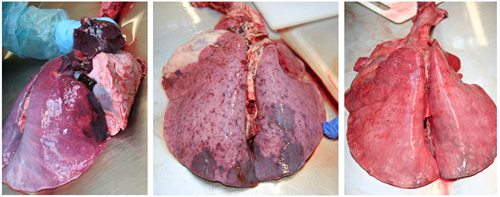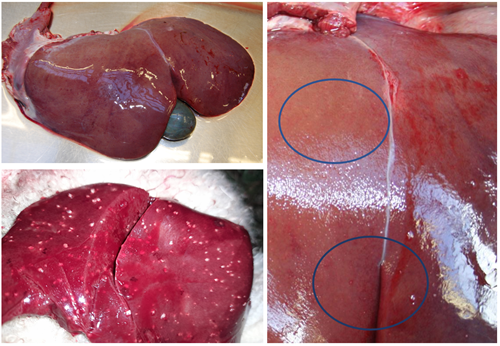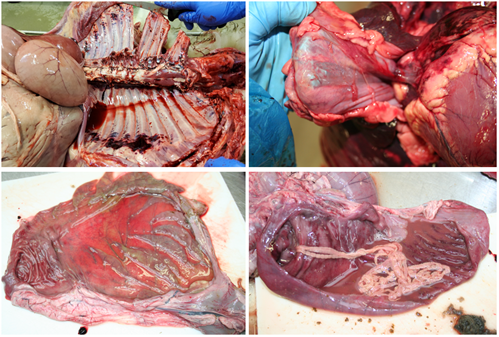Systemic Pasteurellosis in lambs
Systemic Pasteurellosis is caused by the bacteria Bibersteinia trehalosi (formerly Pasteurella trehalosi) and is a common cause of death in weaned lambs between September and December. This bacteria is found in the throat and tonsils of sheep, however periods of stress can lead to septicaemia and the death of affected lambs. Lambs can be found unwell or recumbent in the field however are most commonly found dead with no period of ill health seen. Mortality can be high with losses of 20 to 50% reported but is more commonly around 2% in most outbreaks.
The ‘stresses’ associated with systemic Pasteurellosis include weaning, handling, transport, mixing, movement to good grazing, and change to cold, wet weather. It is not uncommon to find that lambs which have died of systemic Pasteurellosis also have other conditions which may be contributing to their stress; these include worm burdens, fluke burdens, tick-borne fever and selenium and/or cobalt deficiency.
There are some years (such as 2022) where we see increased outbreaks of systemic Pasteurellosis. While the reasons are unclear, we could speculate that warm wet Autumn weather may lead to increased pasture worm burdens, prolonged tick activity and perhaps an increase in trace element deficiencies which, when combined with routine husbandry procedures and/or changeable weather, can increase disease outbreaks.
Diagnosis
Diagnosis is by post mortem examination and bacterial culture of B. trehalosi from systemic sites (sterile, charcoal swabs on liver and lung are extremely useful). B. trehalosi causes a variable pattern of pathology on gross examination, and often examination of multiple carcases is required to reach a confident diagnosis on gross examination alone. Sampling faeces for WEC and some fresh liver for trace element analysis can be useful in identifying some predisposing conditions.

The pharyngeal and oesophageal ulceration seen in B. trehalosi septicaemia can be variable and are often absent in peracute cases. Lesions can be localised to the pharynx (top) or present as superficial ulceration of the oesophageal mucosa (middle) or as classical longitudinal linear oesophageal ulceration (bottom).

Lung lesions due in B. trehalosi infection can vary from classical cranio-ventral consolidation (left) which is indistinguishable grossly from other causes of bacterial pneumonia, to diffuse petechial and ecchymotic haemorrhages on the pleural surface (middle). Petechial haemorrhages can also be very subtle (right).

The hepatic lesions due to B. trehalosi can vary. Often there are no necrotic foci visible, however rounding of the edges of the liver lobes suggestive of septicaemia can be seen (top). Necrotic foci typical of B. trehalosi can be remarkably subtle (right, pinpoint foci are most visible within the circled areas). The classical lesions described in most texts are shown in the bottom left picture (Image from B Armstrong).

Other systemic signs of B. trehalosi infection include ‘blood splash’ haemorrhages on the parietal pleura in the thoracic cavity (top left) in addition to haemorrhages present in the subcutaneous tissues. These lesions can be missed if the carcase is not stabilised and skinned, and/or the thoracic viscera are not removed from the carcase. Less commonly B. trehalosi septicaemia can cause pericarditis (top right), abomasitis (bottom left) and typhlitis (bottom right; the tapeworm are an incidental finding).
Treatment
Antibiotic treatment of the whole affected group has been advised historically, however in the current climate of responsible antibiotic use, it is challenging to justify, and since losses rarely exceed 2%, antibiotic treatment is often not cost effective. In larger outbreaks then use of a group D antibiotic such as oxytetracycline or amoxicillin can be considered.
Prevention
Pasteurella strains are included in many multivalent clostridial vaccines or as standalone Pasteurella vaccine. Full vaccination, according to the product data sheet, completed prior to the period of risk remains a cornerstone of control, though it should be noted that vaccines are unlikely to be completely protective in the face of significant stress. Prevention of systemic Pasteurellosis also relies on controlling the controllables and reducing the stresses on weaned lambs whenever possible.
Posted by SRUC Veterinary Services on 28/11/2022
